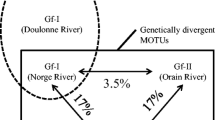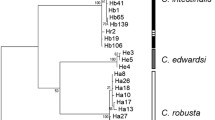Abstract
Four geographic strains of B. calyciflorus are investigated regarding their genetic similarity and ability to cross-mate. DNA sequence analysis of the mitochondrial cox1 gene (694 bp) and the nuclear ribosomal ITS region (735 bp) showed that the Florida and Georgia strains were very similar to each other (0.3% sequence divergence for the 1429 bp) and different from the Texas and Australia strains (~7% and 9% sequence divergence for the 1429 bp, respectively). Consistent with this genetic relatedness, cross-copulation occurred only between the Florida and Georgia strains. Thus, B. calyciflorus is a complex of cryptic species. While the Florida, Texas and Australia strains were reproductively isolated from one another, most combinations of cross-strain mating tests showed intense and prolonged male circling behavior following male–female encounters. This suggests that precopulatory male circling and copulation are two separate behaviors that may be controlled by different female chemicals and male coronal receptors. In some cross-strain mating tests, females regularly retracted their corona when circled by a male, indicating that they can recognize ‘foreign’ males and actively interfere with copulation.
Similar content being viewed by others
References
J. C. Avise (1994) Molecular Markers, Natural History and Evolution Chapman & Hall Inc New York NY
J. C. Avise D. Walker (1999) ArticleTitleSpecies realities and numbers in sexual vertebrates: perspectives from an asexually transmitted genome Proceedings of the National Academy of Sciences USA 96 992–995 Occurrence Handle10.1073/pnas.96.3.992
J. Ciros-Pérez A. Gómez M. Serra (2001) ArticleTitleOn the taxonomy of three sympatric sibling species of the Brachionus plicatilis (Rotifera) complex from Spain, with the description of B. ibericus n. sp Journal of Plankton Research 23 1311–1328 Occurrence Handle10.1093/plankt/23.12.1311
A. M. Derry P. D. N. Hebert E. E. Prepas (2003) ArticleTitleEvolution of rotifers in saline and subsaline lakes: a molecular phylogenetics approach Limnology and Oceanography 48 675–685
O. Folmer M. Black W. Hoeh R. Lutz R. Vrijenhoek (1994) ArticleTitleDNA primers for amplification of mitochondrial cytochrome c oxidase subunit 1 from diverse metazoan invertebrates Molecular Marine Biology and Biotechnology 3 294–299 Occurrence Handle7881515
J. J. Gilbert (1963) ArticleTitleContact chemoreception, mating behaviour, and sexual isolation in the rotifer genus Brachionus Journal of Experimental Biology 40 625–641
J. J. Gilbert (2002) ArticleTitleEndogenous regulation of environmentally induced sexuality in a rotifer: a multigenerational parental effect induced by fertilisation Freshwater Biology 47 1633–1641 Occurrence Handle10.1046/j.1365-2427.2002.00900.x
J. J. Gilbert (2003) ArticleTitleSpecificity of crowding response that induces sexuality in the rotifer Brachionus Limnology and Oceanography 48 1297–1303
J. J. Gilbert (2004) ArticleTitlePopulation density, sexual reproduction and diapause in monogonont rotifers: new data for Brachionus and a review Journal of Limnology 63 IssueID(Suppl. 1) 32–36
A. Gómez M. Serra (1995) ArticleTitleBehavioral reproductive isolation among sympatric strains of Brachionus plicatilis Müller 1786: insights into the status of this taxonomic species Hydrobiologia 313/314 111–119 Occurrence Handle10.1007/BF00025938
A. Gómez M. Serra (1996) ArticleTitleMate choice in male Brachionus plicatilis rotifers Functional Ecology 10 681–687
A. Gómez M. Serra G. R. Carvalho D. H Lunt (2002) ArticleTitleSpeciation in ancient cryptic species complexes: evidence from the molecular phylogeny of Brachionus plicatilis (Rotifera) Evolution 56 1431–1444
W. Koste R. J. Shiel (1987) ArticleTitleRotifera from Australian inland waters II. Epiphanidae and Brachionidae (Rotifera: Monogononta) Invertebrate Taxonomy 1 949–1021 Occurrence Handle10.1071/IT9870949
L. A. Kutikova C. H. Fernando (1995) ArticleTitleBrachionus calyciflorus Pallas (Rotatoria) in inland waters of tropical latitudes Internationale Revue der gesamten Hydrobiologie 80 429–441
C. E. Lee (2000) ArticleTitleGlobal phylogeography of a cryptic copepod species complex and reproductive isolation between genetically proximate “populations” Evolution 54 2014–2027 Occurrence Handle11209778
C. E. Lee B. W. Frost (2002) ArticleTitleMorphological stasis in the Eurytemora affinis species complex (Copepoda: Temoridae) Hydrobiologia 480 111–128 Occurrence Handle10.1023/A:1021293203512
E. N. Moriyama J. R. Powell (1996) ArticleTitleIntraspecific nuclear DNA variation in Drosophilia Molecular Biology and Evolution 13 261–277 Occurrence Handle8583899
H. Segers (1995) ArticleTitleNomenclatural consequences of some recent studies of Brachionus plicatilis (Rotifera, Brachionidae) Hydrobiologia 313/314 121–122 Occurrence Handle10.1007/BF00025939
T. W. Snell (1998) ArticleTitleChemical ecology of rotifers Hydrobiologia 387/388 267–276 Occurrence Handle10.1023/A:1017087003334
T. W. Snell M. Childress (1987) ArticleTitleAging and loss of fertility in male and female Brachionus plicatilis (Rotifera) International Journal of Invertebrate Reproduction and Development 12 103–110
T. W. Snell M. J. Childress B. C. Winkler (1988) ArticleTitleCharacteristics of the mate recognition factor in the rotifer Brachionus plicatilis Comparative Biochemistry and Physiology 89A 481–485
T. W. Snell F. H. Hoff (1987) ArticleTitleFertilization and male fertility in the rotifer Brachionus plicatilis Hydrobiologia 147 329–334 Occurrence Handle10.1007/BF00025762
T. W. Snell R. Rico-Martinez L. N. Kelly T. E. Battle (1995) ArticleTitleIdentification of a sex pheromone from a rotifer Marine Biology 123 347–353 Occurrence Handle10.1007/BF00353626
Swofford, D. L., 2002. PAUP*. Phylogenetic analysis using parsimony (* and other methods), vers. 4.0. Sinauer Associates, Sunderland, MA
J. D. Thompson D. G. Higgings T. J. Gibson. (1994) ArticleTitleClustal W: improving the sensitivity of progressive multiple sequence alignment through sequencing weighting, position specific gap penalties and weight matrix choice Nucleic Acids Research 22 4676–4680
White T. J., J. Bruns, S. Lee & J. Taylor, 1990. Amplification and direct sequencing of fungal ribosomal RNA genes for phylogenetics. In Innis, M., D. Gelfand, J. Sninsky & T. White (eds), PCR Protocols: A Guide to Methods and Applications
Zar J. H., 1999. Biostatistical Analysis. Prentice Hall
Author information
Authors and Affiliations
Rights and permissions
About this article
Cite this article
Gilbert, J.J., Walsh, E.J. Brachionus calyciflorus is a Species Complex: Mating Behavior and Genetic Differentiation Among Four Geographically Isolated Strains. Hydrobiologia 546, 257–265 (2005). https://doi.org/10.1007/s10750-005-4205-3
Accepted:
Issue Date:
DOI: https://doi.org/10.1007/s10750-005-4205-3




